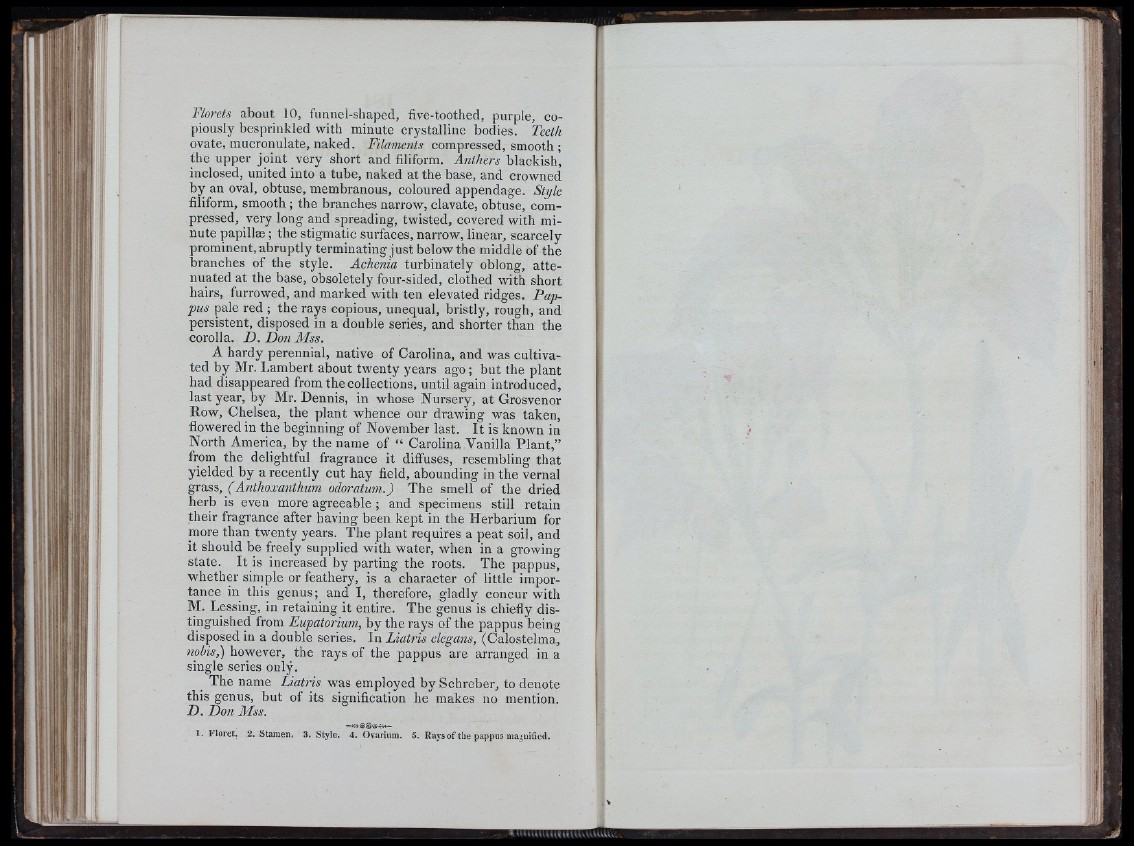
m
i
Florets about 10, funnel-shaped, iive-toothed, purple, copiously
besprinkled with minute crystalline bodies. Teeth
ovate, mucronulate, naked. Filaments compressed, smooth ;
the upper joint very short and filiform. Anthers blackish,
inclosed, united into a tube, naked at the base, and crowned
by an oval, obtuse, membranous, coloured appendage. Style
filiform, smooth ; the branches narrow, clavate, obtuse, compressed,
very long and spreading, twisted, covered with minute
papillæ ; the stigmatic surfaces, narrow, linear, scarcely
prominent, abruptly terminating just below the middle of the
branches of the style. Achenia turbinately oblong, attenuated
at the base, obsoletely four-sided, clothed with short
hairs, furrowed, and marked with ten elevated ridges. Pappus
pale red ; the rays copious, unequal, bristly, rough, and
persistent, disposed in a double series, and shorter than the
corolla. D . Don Mss.
A hardy perennial, native of Carolina, and was cultivated
by Mr. Lambert about twenty years ago ; but the plant
had disappeared from the collections, until again introduced,
last year, by Mr. Dennis, in whose Nursery, at Grosvenor
Row, Chelsea, the plant whence our drawing was taken,
fiowered in the beginning of November last. It is known in
North America, by the name of “ Carolina Vanilla Plant,”
from the delightful fragrance it diffuses, resembling that
yielded by a recently cut hay field, abounding in the vernal
grass, ( Anthoxanthum odoratum.) The smell of the dried
herb is even more agreeable ; and specimens still retain
their fragrance after having been kept in the Herbarium for
more than twenty years. The plant requires a peat soil, and
it should be freely supplied with water, when in a growing
state. It is increased by parting the roots. The pappus,
whether simple or feathery, is a character of little importance
in this genus; and I, therefore, gladly concur with
M. Lessing, in retaining it entire. The genus is chiefiy distinguished
from Eupatoi'ium, by the rays of the pappus being
disposed in a double series. In Liatris elegans, (Calostelma,
nohis,) however, the rays of the pappus are arranged in a
single series only.
The name Liatris was employed by Schreber, to denote
this genus, but ot its signification he makes no mention.
D . Don Mss.
1. F lo r et. 2. Stamen, 3. S ty le . 4 . Ovarium. 5 . Rays o f the pappus magnified.
siuuuummiuGuwu.